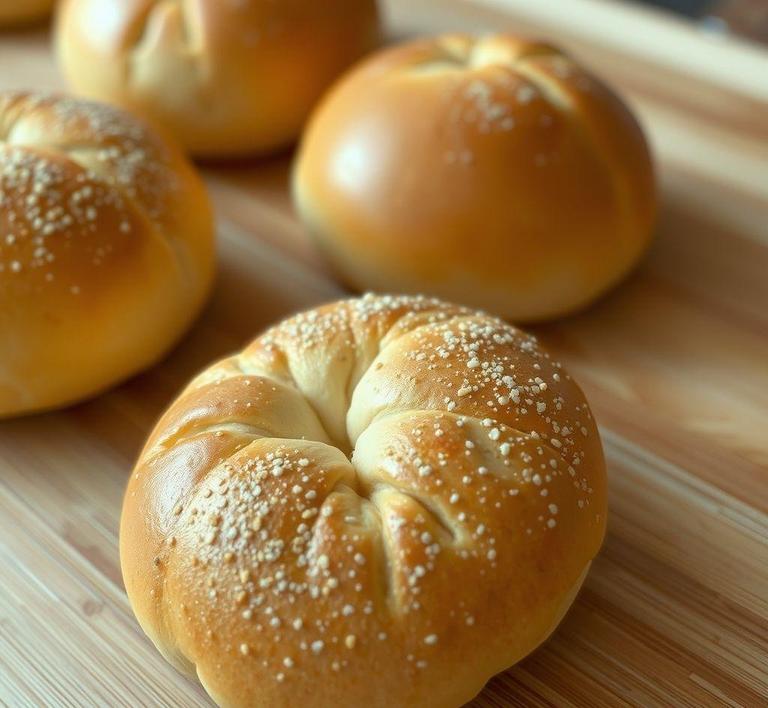Ever wondered if you can refreeze bread buns without ruining their texture or taste? Well, you’re not alone! Whether you’ve bought a big pack and can’t finish them in one sitting, or you’re just looking to save some for later, refreezing bread buns can actually be a smart and efficient way to prevent waste. In this guide, we’ll walk you through the best methods for safely refreezing bread buns so they stay fresh and delicious when you thaw them out again. From the right wrapping techniques to the optimal freezing time, we’ll cover everything you need to know to make sure your buns taste as good as new!
Can You Refreeze Bread Buns?

The idea of refreezing bread buns might seem a little strange at first. After all, isn’t freezing bread supposed to preserve its freshness, and doesn’t refreezing somehow seem like a bad idea? Well, you can refreeze bread buns, but there are several important considerations before doing so. First, let’s break down the reasons behind this question.
Bread, like most baked goods, contains a lot of water and air. When bread is frozen, the water within the dough forms ice crystals. Freezing slows down the staling process, preserving the flavor and texture of the bread. However, when bread is refrozen after being thawed, the ice crystals inside the dough can cause significant changes. Refreezing bread buns can alter their texture, making them soggy or overly dry, and sometimes impacting the flavor in unexpected ways.
So, yes-technically, you can refreeze bread buns, but it’s not always the best practice if you’re aiming to keep them at their optimal quality. There are a few ways to manage this, but it will depend on how the bread buns were thawed and how you plan to use them after the refreeze.
How To Refreeze Bread Buns?
If you find yourself in a situation where refreezing bread buns is necessary, you’ll want to take a few precautions to minimize any negative effects on the quality of the buns. Here’s a step-by-step guide on how to refreeze them properly:
-
Ensure Proper Thawing:
The first step is how you thawed the bread buns. If you thawed the buns on the countertop, they should not be left out for more than a few hours before refreezing. This is to avoid the growth of bacteria. The best way to thaw bread is either in the fridge (where it can slowly defrost without risking bacterial growth) or by using the microwave if you’re in a hurry. However, once they’ve thawed, don’t leave them at room temperature for extended periods if you’re planning to refreeze.
-
Wrap the Buns Well:
If you’re planning to refreeze the bread buns, the key is to wrap them tightly. Use plastic wrap or aluminum foil to completely seal the buns. This prevents air from getting in and helps avoid freezer burn, which can further degrade the texture of the bread. After wrapping, place the buns in a freezer-safe zip-top bag or an airtight container for extra protection.
-
Refreeze Quickly:
The sooner you get the bread buns back in the freezer, the better. Buns that sit around too long after being thawed will lose moisture, leading to a less pleasant refreeze. To minimize quality loss, try to place them in the freezer within a few hours of thawing.
-
Label and Date the Buns:
To keep track of the refrozen buns, label the bag or container with the date they were refrozen. Bread, even frozen, has a limited shelf life. Refrozen bread can usually stay good for about a month or so, but the longer it sits, the more its quality will degrade.
Quality Impact
When it comes to refreezing bread buns, the biggest concern is how the texture and flavor will be affected. While it’s safe to refreeze bread, it can change quite a bit in terms of quality.
-
Texture Changes:
Bread is made up of a delicate structure of starches, sugars, and water. When bread is frozen, the water in the dough turns into ice. When thawed, this can result in a shift in the structure of the starches, making them more fragile. Refreezing bread causes further disruption to the starches and water. The ice crystals that form during the second freeze can be larger and more damaging, which is why refrozen bread often becomes dry or mushy. You may notice a loss of fluffiness, and the buns could have a dense or crumbly texture when eaten.
-
Soggy or Dry Texture:
If your buns are refrozen after being thawed at room temperature, you might find they are excessively dry when reheated. This happens because the buns can lose moisture during the thawing and freezing process. Alternatively, if they weren’t wrapped well enough and have absorbed moisture from the air in the freezer, they may become soggy after being reheated.
-
Flavor Deterioration:
As bread freezes and thaws, the enzymes in the dough slowly continue their work, even in the cold. This can result in a slight degradation of flavor over time. Refreezing can intensify this, especially if the bread has already been thawed and exposed to air. Some people report a slight "stale" taste or an overall loss of the fresh, soft flavor of freshly baked bread.
-
Freezer Burn:
Without proper wrapping, freezer burn can quickly affect refrozen buns. Freezer burn occurs when air makes contact with the food, causing dehydration and oxidation. If buns are exposed to freezer burn, they will lose not just moisture but also flavor, making them unpleasant to eat.
While it is entirely possible to refreeze bread buns, it’s important to consider the potential impacts on quality. The texture and flavor of the bread can suffer with refreezing due to moisture loss, ice crystal damage, and possible freezer burn. If you plan to refreeze bread buns, be sure to wrap them tightly and store them in an airtight container to minimize these effects. Additionally, it’s best to consume the refrozen buns within a reasonable time frame to ensure they still taste good.
If you’re simply looking to prolong the life of your buns without sacrificing quality, consider freezing them initially in portions that you know you’ll use at once. This way, you can avoid refreezing altogether and enjoy fresher buns when you need them!
Is It Safe To Refreeze Bread Buns?
Refreezing bread buns can be a convenient way to preserve food, but whether it is safe depends on a few crucial factors. The primary concern with refreezing any type of food is how it impacts the texture, flavor, and quality, and bread is no exception.
When bread buns are initially frozen, the process preserves their freshness by halting the activity of microorganisms that cause spoilage. However, freezing does not kill bacteria or yeast entirely, and once bread buns are thawed, they are exposed to air, moisture, and potential bacteria growth. Refreezing bread buns after they’ve been thawed can lead to a breakdown in their structure due to the water molecules in the dough that expand and contract with each freeze-thaw cycle. This results in a potential loss of flavor, texture, and overall freshness.
From a food safety perspective, the primary risk of refreezing bread buns is the potential for bacterial growth. If the bread buns have been left at room temperature for an extended period or have been stored improperly, refreezing them may not be safe. As long as the bread buns were properly thawed in the refrigerator and not exposed to temperatures above 40°F (4°C) for more than two hours, it is typically safe to refreeze them. However, keep in mind that the more times you freeze and thaw bread, the greater the risk of bacterial contamination and the more degraded the quality of the buns will be.
Signs That Bread Buns Should Not Be Refrozen
There are several indicators that suggest bread buns should not be refrozen, particularly when considering the safety and quality of the product:
- Unpleasant Odor: A sour or off-smell emanating from the bread buns after thawing is a sure sign that the bread has begun to spoil. In this case, refreezing will only further compromise the quality and taste.
- Visible Mold or Fungus: If you notice any mold or greenish/black spots on the buns, they have begun to spoil. Mold growth is a clear indication that the bread is no longer safe to eat, let alone refreeze.
- Softness or Mushiness: If the buns have become overly soft or mushy after thawing, it suggests that the moisture content has altered significantly. This change in texture is a result of ice crystals melting and reabsorbing into the bread, and refreezing will only make the texture worse.
- Changes in Color: If the bread turns a darker shade or appears discolored after thawing, it might indicate the breakdown of the bread’s natural ingredients. This can affect both the flavor and safety of the bread, making it unsuitable for refreezing.
- Room Temperature Exposure: If bread buns have been left out at room temperature for more than a couple of hours (especially in hot or humid environments), the risk of bacterial growth increases. At this point, refreezing could lead to foodborne illness, and it’s best to discard the buns.
Common Refreezing Mistakes
Refreezing bread buns may seem straightforward, but there are a few common mistakes people often make that can degrade both the safety and quality of the bread. Let’s break down some of the top mistakes:
- Thawing Bread at Room Temperature: A common mistake is leaving frozen bread buns out at room temperature to thaw, especially when in a warm environment. This can cause bacteria to grow, especially if the buns sit out for too long. The best way to thaw bread is by placing it in the refrigerator, where it can thaw gradually and safely.
- Refreezing Multiple Times: Repeatedly freezing and thawing bread buns not only ruins their texture but also increases the chances of foodborne illness. Each time the bread is thawed and refrozen, the moisture content increases, leading to more freezer burn and poor texture.
- Freezing Without Proper Packaging: Many people neglect to wrap bread buns properly before freezing. This can lead to freezer burn, where the buns become dry and tough. The bread should be tightly wrapped in plastic wrap or foil and placed in an airtight container or freezer bag to prevent air from reaching it.
- Not Checking the Freezer Temperature: If your freezer is not consistently at or below 0°F (-18°C), the bread will not stay in optimal condition. A fluctuating temperature can cause partial thawing and refreezing, which can ruin the bread’s texture and make it unsafe to eat.
- Thawing in the Microwave: While it’s tempting to use the microwave to quickly thaw bread, it can lead to uneven heating, making the bread soggy in some spots and dried out in others. This inconsistency can make refreezing a poor option because you’ll end up with inconsistent texture and flavor once it’s thawed again.
Tips And Tricks
To make the most out of freezing and potentially refreezing bread buns, here are a few tips and tricks that will help preserve their taste and texture:
- Wrap Buns Properly: For best results, wrap each bread bun individually in plastic wrap, followed by a layer of aluminum foil. After that, place the buns in a freezer-safe, resealable bag to minimize air exposure.
- Pre-Slice Before Freezing: If you plan on freezing bread buns and don’t want to thaw the entire batch, slice them before freezing. This allows you to pull out just what you need without having to thaw the whole loaf or batch.
- Flash Freeze: If you’re freezing a large batch of bread buns, flash freezing is a great technique. Lay the buns on a baking sheet in a single layer and freeze them for a few hours before transferring them to bags. This method ensures that the buns don’t stick together, making it easier to pull out just the amount you need.
- Store in Optimal Conditions: Make sure your freezer is operating at 0°F (-18°C) or lower. Also, avoid storing bread near the freezer door where temperature fluctuations are more common.
- Limit Refreezing: For optimal quality, only freeze and thaw bread buns once. If you must refreeze them, try to consume them as soon as possible after thawing to avoid further degradation of texture and flavor.
- Thaw Properly: When you’re ready to use your frozen bread buns, place them in the refrigerator to thaw slowly. If you’re in a rush, you can thaw them at room temperature for a few hours, but make sure they’re not left out too long.
- Reheat with Care: To bring bread buns back to life after thawing, lightly toast or warm them in the oven. A few minutes at 350°F (175°C) can revive the texture, making them taste fresh once again.
Conclusion
Refreezing bread buns is not an automatic yes-it depends on several factors like how well they were stored and how they were thawed initially. If the buns have been stored properly and have not been exposed to room temperature for too long, refreezing them is generally safe. However, multiple cycles of freezing and thawing can lead to a decline in both safety and quality. To preserve the freshness of your bread, it’s crucial to follow best practices such as proper packaging, thawing in the fridge, and limiting the number of freeze-thaw cycles. By following these steps, you can ensure that your bread buns remain delicious and safe to eat, even after being frozen and thawed.


